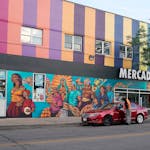Dry-cleaning, hamburgers, coffee, cash, pills and even prayers — they're all within reach of the car window nowadays at drive-throughs across the Twin Cities.
But some Minneapolis leaders want to clamp down on drive-throughs in favor of people traveling the city on foot. A change to city rules in its early stages would likely further restrict where drive-throughs could be installed in the city.
"The streets where a lot of people are walking, on our transit corridors, maybe we don't want to have drive-throughs at all," said Council Member Lisa Bender, who sponsored the proposal with Council Member Lisa Goodman. "If we do, we may want to strengthen our controls of them and minimize their impact on people walking."
Similar debates have played out in city halls across the Twin Cities and the country, as local planners strive to create bustling districts meant to be enjoyed at 3 — rather than 30 — miles per hour.
That can mean discouraging drive-throughs and surface parking lots, while emphasizing buildings with ample ground-level windows and a mix of apartments and businesses.
One need look no further than Uptown, arguably the city's most walked commercial area outside downtown, for a snapshot of the drive-through dilemma.
Wells Fargo is overhauling its West Lake Street branch with two drive-through lanes, a new Bank of America on Hennepin Avenue has a drive-through facing the sidewalk and a proposal was recently unveiled for a Walgreens with car pickup window in place of Roat Osha, a Thai restaurant.
Walgreens has been rapidly building new stores with prescription pickup lanes near existing locations across the Twin Cities, as leases on those older buildings expire after two decades. The developer says the lanes are a valuable asset to elderly customers, people with compromised immune systems and mothers toting children.
"The last thing they really want to do is go to a drugstore, unhook the kids out of the harnesses, and take them in and get the pills and then go back and hook them all up again," said Howard Bergerud, president of Semper Development, the primary developer of Walgreens in the Twin Cities.
Goodman said the Hennepin Walgreens proposal essentially puts a suburban-style building in a dense urban setting, where vehicle lanes cutting into the sidewalk conflict with walking. "Maybe they should consider delivery," Goodman said. "I realize we're not New York, but there's lots of land for drive-throughs in the suburbs."
Drive-throughs have also been a concern of the city's pedestrian advisory committee, said Chairwoman Greta Alquist, particularly because of the safety risk to walkers. But they also have discussed their effect on streetscape aesthetics and air quality — due to the idling cars.
"If [a company is] going to come here no matter what, we would like to have a say about what that does to our neighborhoods and what that does to our walking environment," Alquist said.
Walkers passing by the new Bank of America drive-through on Thursday night expressed mixed opinions about the notion of restricting them.
"I walk here all the time and I'm not concerned," said Caroline Rice, adding that the ATM would be very helpful if she banked there.
"I don't entirely feel 100 percent safe with the traffic turning in, [particularly] on Hennepin like this," said Christine Schmidt. "Because you're always having to watch your back."
Another passer-by, Kathy Moran, said she wrote to the City Council about the layout of that particular parking lot and drive-through, which is arranged with a lane perpendicular to the sidewalk. "The cars coming in are usually just primed to hit the accelerator when there's a break in the traffic," Moran said. "And they don't necessarily look beyond the lane of traffic to the pedestrian, to a car possibly coming in the opposing direction."
Different zoning rules
Minneapolis already bars drive-throughs in nearly all corners of downtown, in the denser commercial zones of the central riverfront and Uptown, and in special pedestrian-oriented districts. Yet the new Bank of America and future Uptown Walgreens fell outside those areas, despite having heavy walking traffic.
The city's planning manager Jason Wittenberg said the precise number of applications is hard to track, though it appears to have increased slightly as Walgreens replaces older stores. Most applications in recent years have been from the drugstore chain, banks and McDonalds.
St. Paul allows drive-throughs in most areas of downtown, but prohibits them in zones most common along the Green Line light rail. They require special permission in lower-density commercial areas.
Drive-through bans have been proposed or implemented in a number cities — particularly smaller ones — across the country. San Luis Obispo, Calif., has prohibited them since 1982.
Burnsville ban overturned
In the Twin Cities, Burnsville banned drive-throughs in an urban-style district known as Heart of the City until the City Council overturned that measure in 2009. It was hoped that allowing drive-throughs would woo major tenants, such as a Dunkin' Donuts. A CVS with a drive-through has since moved in, said city manager Heather Johnston.
Falcon Heights imposed a moratorium on drive-throughs and undertook an extensive review of the issue in 2006 after Dino's Gyros restaurant proposed installing one. The city ultimately crafted new rules allowing only drive-throughs attached to banks and financial institutions.
"The real issue was the proximity to the neighborhood," said Falcon Heights Mayor Peter Lindstrom. "And neighbors being concerned about the noise of the drive-through. Just the noise of the cars and the radios, and the car headlights flashing into their windows."
Neighbors of a McDonald's on Broadway and University avenues in Minneapolis expressed similar nuisance concerns in 2014, when the restaurant proposed adding another drive-through lane. McDonald's ultimately agreed to install a better lighting system, quiet the intercom and improve landscaping.
The details of Minneapolis' drive-through change will be worked out in the coming weeks before returning to the City Council.
Eric Roper • 612-673-1732
Twitter: @StribRoper





